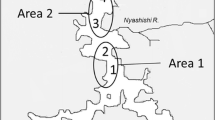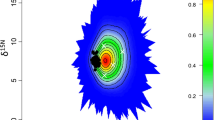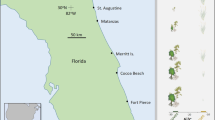Abstract
The co-occurrence of several species, all of which share similar resource requirements, remains a paradox in ecology. Here, I evaluated resource use along multiple environmental axes to understand the potential for niche partitioning and complementarity in a guild of suspension-feeding rocky shore invertebrates. I focused on the mussels Perna canaliculus, Mytilus galloprovincialis, Aulacomya maoriana, and Xenostrobus pulex, all of which coexist along the coastline of the South Island of New Zealand. I quantified the mussels’ distributions, both vertically on the shore and within the three-dimensional mussel bed matrix, and used carbon (δ13C) and nitrogen (δ15N) stable isotope ratios to compare species’ diets. Mussels exhibited niche partitioning along all resource axes. Given the mussels’ use of different spatial and food resources, I evaluated the potential for complementarity with respect to mussels’ roles as mediators of an important spatial subsidy, carbon inputs from the nearshore ocean into rocky-shore ecosystems. In these systems, mussels are basal species, capturing and consuming particulate organic matter in the ocean and making it available for local consumption within the benthic community. I found that mussel diversity matters; even the most productive species—Perna canaliculus—only contributed about half of the mussel-mediated carbon that accumulated over a year. Multiple co-occurring species are, therefore, likely to provide more carbon at the base of the intertidal food web than any one species living independently, and complementarity in resource use along multiple environmental axes is likely an important mechanism underlying this relationship.






Similar content being viewed by others
References
Baker SM (1909) On the causes of the zoning of brown seaweeds on the seashore. New Phytol 8:196–202. https://doi.org/10.1111/j.1469-8137.1909.tb05523.x
Batham EJ (1958) Ecology of southern New Zealand exposed rocky shore at Little Papanui, Otago Peninsula. Trans R Soc NZ 85:647–658
Bracken MES (2017) Stoichiometric mismatch between consumers and resources mediates the growth of rocky intertidal suspension feeders. Front Microbiol 8:1297. https://doi.org/10.3389/fmicb.2017.01297
Bracken M (2020) Data supporting analyses of complementarity in spatial subsidies of carbon associated with resource partitioning along multiple niche axes. Dryad Digital Repository. https://doi.org/10.7280/D1696J
Bracken MES, Menge BA, Foley MM, Sorte CJB, Lubchenco J, Schiel DR (2012) Mussel selectivity for high-quality food drives carbon inputs into open-coast intertidal ecosystems. Mar Ecol Prog Ser 459:53–62. https://doi.org/10.3354/meps09764
Burson A, Stomp M, Mekkes L, Huisman J (2019) Stable coexistence of equivalent nutrient competitors through niche differentiation in the light spectrum. Ecology 100:e02873. https://doi.org/10.1002/ecy.2873
Bustamante RH, Branch GM (1996) The dependence of intertidal consumers on kelp-derived organic matter on the west coast of South Africa. J Exp Mar Biol Ecol 196:1–28. https://doi.org/10.1016/0022-0981(95)00093-3
Canuel EA, Cloern JE, Ringelberg DB, Guckert JB, Rau GH (1995) Molecular and isotopic tracers used to examine sources of organic matter and its incorporation into the food webs of San Francisco Bay. Limnol Oceanogr 40:67–81. https://doi.org/10.4319/lo.1995.40.1.0067
Cardinale BJ, Wright JP, Cadotte MW, Carroll IT, Hector A, Srivastava DS, Loreau M, Weis JJ (2007) Impacts of plant diversity on biomass production increase through time because of species complementarity. Proc Natl Acad Sci USA 104:18123–18128. https://doi.org/10.1073/pnas.0709069104
Chesson P, Huntly N (1997) The roles of harsh and fluctuating conditions in the dynamics of ecological communities. Am Nat 150:519–553. https://doi.org/10.1086/286080
Cohen JE, Briand F (1984) Trophic links of community food webs. Proc Natl Acad Sci USA 81:4105–4109. https://doi.org/10.1073/pnas.81.13.4105
Colgan DJ, da Costa P (2013) Invasive and non-invasive lineages in Xenostrobus (Bivalvia: Mytilidae). Mollusc Res 33:272–280. https://doi.org/10.1080/13235818.2013.826574
Connell JH (1961) The influences of interspecific competition and other factors on the distribution of the barnacle Chthamalus stellatus. Ecology 42:710–723. https://doi.org/10.2307/1933500
d’Ovidio F, De Monte S, Alvain S, Dandonneau Y, Lévy M (2010) Fluid dynamical niches of phytoplankton types. Proc Natl Acad Sci USA 107:18366–18370. https://doi.org/10.1073/pnas.1004620107
Darwin CR (1839) Journal of researches into the geology and natural history of the various countries visited by H.M.S. Beagle. Colburn, London.
Dayton PK (1971) Competition, disturbance, and community organization: the provision and subsequent utilization of space in a rocky intertidal community. Ecol Monogr 41:351–389. https://doi.org/10.2307/1948498
de Lamarck JBM (1819) Histoire naturelle des animaux sans vertèbres. Tome sixième, 1re partie. Paris
Dehnel PA (1956) Growth rates in latitudinally and vertically separated populations of Mytilus californianus. Biol Bull 110:43–53. https://doi.org/10.2307/1538891
Demello R, Phillips NE (2011) Variation in mussel and barnacle recruitment parallels a shift in intertidal community structure in the Cook Strait region of New Zealand. Mar Freshw Res 62:1221–1229. https://doi.org/10.1071/MF11053
Descamps-Julien B, Gonzalez A (2005) Stable coexistence in a fluctuating environment: an experimental demonstration. Ecology 86:2815–2824. https://doi.org/10.1890/04-1700
Doty MS (1946) Critical tide factors that are correlated with the vertical distribution of marine algae and other organisms along the Pacific coast. Ecology 27:315–328. https://doi.org/10.2307/1933542
Doty MS, Archer JG (1950) An experimental test of the tide factor hypothesis. Am J Bot 37:458–464. https://doi.org/10.2307/2438217
Dubois S, Jean-Louis B, Bertrand B, Lefebvre S (2007) Isotope trophic-step fractionation of suspension-feeding species: Implications for food partitioning in coastal ecosystems. J Exp Mar Biol Ecol 351:121–128. https://doi.org/10.1016/j.jembe.2007.06.020
Fargione J, Tilman D, Dybzinski R, Hille Ris Lambers J, Clark C, Harpole WS, Knops JMH, Reich PB, Loreau M (2007) From selection to complementarity: shifts in the causes of biodiversity-productivity relationships in a long-term biodiversity experiment. Proc R Soc B Biol Sci 274:871–876. https://doi.org/10.1098/rspb.2006.0351
Flater D (1998) XTide 2.15.2. FlaterCo, Germantown, Maryland
Gardner JPA (2002) Effects of seston variability on the clearance rate and absorption efficiency of the mussels Aulacomya maoriana, Mytilus galloprovincialis and Perna canaliculus from New Zealand. J Exp Mar Biol Ecol 268:83–101. https://doi.org/10.1016/S0022-0981(01)00378-1
Gardner JPA (2004) A historical perspective of the genus Mytilus (Bivalvia: Mollusca) in New Zealand: multivariate morphometric analyses of fossil, midden and contemporary blue mussels. Biol J Linn Soc 82:329–344. https://doi.org/10.1111/j.1095-8312.2004.00362.x
Gmelin JF (1791) Vermes. In: Gmelin JF (ed) Caroli a Linnaei Systema Naturae per Regna Tria Naturae, Ed. 13. Tome 1(6). GE Beer, Lipsiae (Leipzig), pp 3021–3910
Hawkins AJS, James MR, Hickman RW, Hatton S, Weatherhead M (1999) Modelling of suspension-feeding and growth in the green-lipped mussel Perna canaliculus exposed to natural and experimental variations of seston availability in the Marlborough Sounds, New Zealand. Mar Ecol Prog Ser 191:217–232. https://doi.org/10.3354/meps191217
Helson JG, Gardner JPA (2007) Variation in scope for growth: a test of food limitation among intertidal mussels. Hydrobiologia 586:373–392. https://doi.org/10.1007/s10750-007-0711-9
Helson JG, Pledger S, Gardner JPA (2007) Does differential particulate food supply explain the presence of mussels in Wellington Harbour (New Zealand) and their absence on neighbouring Cook Strait shores? Estuar Coast Shelf Sci 72:223–234. https://doi.org/10.1016/j.ecss.2006.10.015
Hutchinson GE (1961) The paradox of the plankton. Am Nat 95:137–145. https://doi.org/10.1086/282171
Ibarrola I, Arambalza U, Navarro JM, Urrutia MB, Navarro E (2012) Allometric relationships in feeding and digestion in the Chilean mytilids Mytilus chilensis (Hupé), Choromytilus chorus (Molina) and Aulacomya ater (Molina): A comparative study. J Exper Mar Biol Ecol 426–427:18–27. https://doi.org/10.1016/j.jembe.2012.05.012
Iredale T (1915) A commentary on Suter's "Manual of the New Zealand Mollusca". Trans NZ Inst 47:417–497
Kennedy VS (1976) Desiccation, higher temperatures and upper intertidal limits of three species of sea mussels (Mollusca: Bivalvia) in New Zealand. Mar Biol 35:127–137. https://doi.org/10.1007/BF00390934
Kennedy VS (1984) Crawling and clustering behaviour of 3 species of intertidal mussels in New Zealand. NZ J Mar Freshw Res 18:417–423. https://doi.org/10.1080/00288330.1984.9516062
Knox GA (1953) The intertidal ecology of Taylor's Mistake: Banks Peninsula. Trans R Soc NZ 81:189–220
Kraft NJB, Godoy O, Levine JM (2015) Plant functional traits and the multidimensional nature of species coexistence. Proc Natl Acad Sci USA 112:797–802. https://doi.org/10.1073/pnas.1413650112
Lachowicz ŁS (2005) Population biology of mussels (Aulacomya maoriana, Mytilus galloprovincialis, and Perna canaliculus) from rocky intertidal shores in Wellington Harbour, New Zealand. Ph.D. dissertation, School of Biological Sciences, Victoria University of Wellington, New Zealand.
Lafferty KD, Suchanek TH (2016) Revisiting Paine’s 1966 sea star removal experiment, the most-cited empirical article in the American Naturalist. Am Nat 188:365–378. https://doi.org/10.1086/688045
Li L, Chesson P (2016) The effects of dynamical rates on species coexistence in a variable environment: the paradox of the plankton revisited. Am Nat 188:E46–E58. https://doi.org/10.1086/687111
Lovelock CE, Feller IC (2003) Photosynthetic performance and resource utilization of two mangrove species coexisting in a hypersaline scrub forest. Oecologia 134:455–462. https://doi.org/10.1007/s00442-002-1118-y
Lubchenco J (1980) Algal zonation in the New England rocky intertidal community: an experimental analysis. Ecology 61:333–344. https://doi.org/10.2307/1935192
Marsden ID, Weatherhead MA (1999) Shore-level induced variations in condition and feeding of the mussel Perna canaliculus from the east coast of the South Island, New Zealand. NZ J Mar Freshw Res 33:611–622. https://doi.org/10.1080/00288330.1999.9516904
Menge BA (1976) Organization of the New England rocky intertidal community: role of predation, competition, and environmental heterogeneity. Ecol Monogr 46:355–393. https://doi.org/10.2307/1942563
Menge BA, Branch GM (2001) Rocky intertidal communities. In: Bertness MD, Gaines SD, Hay ME (eds) Marine community ecology. Sinauer Associates, Sunderland, pp 221–251
Menge BA, Berlow EL, Blanchette CA, Navarrete SA, Yamada SB (1994) The keystone species concept: variation in interaction strength in a rocky intertidal habitat. Ecol Monogr 64:249–286. https://doi.org/10.2307/2937163
Menge BA, Lubchenco J, Bracken MES, Chan F, Foley MM, Freidenburg TL, Gaines SD, Hudson G, Krenz C, Leslie H, Menge DNL, Russell R, Webster MS (2003) Coastal oceanography sets the pace of rocky intertidal community dynamics. Proc Natl Acad Sci USA 100:12229–12234. https://doi.org/10.1073/pnas.1534875100
Menge BA, Blanchette C, Raimondi P, Freidenburg T, Gaines S, Lubchenco J, Lohse D, Hudson G, Foley M, Pamplin J (2004) Species interaction strength: testing model predictions along an upwelling gradient. Ecol Monogr 74:663–684. https://doi.org/10.1890/03-4060
Menge BA, Daley BA, Sanford E, Dahlhoff EP, Lubchenco J (2007) Mussel zonation in New Zealand: an integrative eco-physiological approach. Mar Ecol Prog Ser 345:129–140. https://doi.org/10.3354/meps06951
Menge BA, Chan F, Lubchenco J (2008) Response of a rocky intertidal ecosystem engineer and community dominant to climate change. Ecol Lett 11:151–162. https://doi.org/10.1111/j.1461-0248.2007.01135.x
Moore SK, Suthers IM (2005) Can the nitrogen and carbon stable isotopes of the pygmy mussel, Xenostrobus securis, indicate catchment disturbance for estuaries in northern New South Wales, Australia? Estuaries 28:714–725. https://doi.org/10.1007/BF02732910
Morton JE, Miller M (1973) The New Zealand sea shore. Collins, London
Newell RC, Field JG (1983) The contribution of bacteria and detritus to carbon and nitrogen flow in a benthic community. Mar Biol Lett 4:23–36
Olli K, Seppälä J (2001) Vertical niche separation of phytoplankton: large-scale mesocosm experiments. Mar Ecol Prog Ser 217:219–233
Paine RT (1971) A short-term experimental investigation of resource partitioning in a New Zealand rocky intertidal habitat. Ecology 52:1096–1106. https://doi.org/10.2307/1933819
Paine RT (1974) Intertidal community structure: experimental studies on the relationship between a dominant competitor and its principal predator. Oecologia 15:93–120. https://doi.org/10.1007/BF00345739
Peterson BJ, Fry B (1987) Stable isotopes in ecosystem studies. Annu Rev Ecol Syst 18:293–320. https://doi.org/10.1146/annurev.es.18.110187.001453
Petes LE, Menge BA, Murphy GD (2007) Environmental stress decreases survival, growth, and reproduction in New Zealand mussels. J Exp Mar Biol Ecol 351:83–91. https://doi.org/10.1016/j.jembe.2007.06.025
Post DM (2002) Using stable isotopes to estimate trophic position: models, methods, and assumptions. Ecology 83:703–718. https://doi.org/10.1890/0012-9658(2002)083[0703:USITET]2.0.CO;2
Rilov G, Schiel DR (2006a) Seascape-dependent subtidal-intertidal trophic linkages. Ecology 87:731–744. https://doi.org/10.1890/04-1853
Rilov G, Schiel DR (2006b) Trophic linkages across seascapes: subtidal predators limit effective mussel recruitment in rocky intertidal communities. Mar Ecol Prog Ser 327:83–93. https://doi.org/10.3354/meps327083
Schiel DR (2011) Biogeographic patterns and long-term changes on New Zealand coastal reefs: non-trophic cascades from diffuse and local impacts. J Exp Mar Biol Ecol 400:33–51. https://doi.org/10.1016/j.jembe.2011.02.026
Seed R (1996) Patterns of biodiversity in the macro-invertebrate fauna associated with mussel patches on rocky shores. J Mar Biol Assoc UK 76:203–210. https://doi.org/10.1017/S0025315400029131
Silvertown J (2004) Plant coexistence and the niche. Trends Ecol Evol 19:605–611. https://doi.org/10.1016/j.tree.2004.09.003
Sorte CJB, Bernatchez G, Mislan KAS, Pandori LLM, Silbiger NJ, Wallingford PD (2019) Thermal tolerance limits as indicators of current and future intertidal zonation patterns in a diverse mussel guild. Mar Biol 166:6. https://doi.org/10.1007/s00227-018-3452-6
Stachowicz JJ, Graham M, Bracken MES, Szoboszlai AI (2008) Diversity enhances cover and stability of seaweed assemblages: the role of heterogeneity and time. Ecology 89:3008–3019. https://doi.org/10.1890/07-1873.1
Stephenson TA, Stephenson A (1949) The universal features of zonation between tide-marks on rocky coasts. J Ecol 37:289–305. https://doi.org/10.2307/2256610
Suchanek TH (1985) Mussels and their role in structuring rocky shore communities. In: Moore PG, Seed R (eds) The ecology of rocky coasts. Hodder & Stoughton, London, pp 70–96
Tallis H (2009) Kelp and rivers subsidize rocky intertidal communities in the Pacific Northwest (USA). Mar Ecol Prog Ser 389:85–96. https://doi.org/10.3354/meps08138
Ward JE, Levinton JS, Shumway SE, Cucci T (1998) Particle sorting in bivalves: in vivo determination of the pallial organs of selection. Mar Biol 131:283–292. https://doi.org/10.1007/s002270050321
Westfall KM, Gardner JPA (2010) Genetic diversity of Southern hemisphere blue mussels (Bivalvia: Mytilidae) and the identification of non-indigenous taxa. Biol J Linn Soc 101:898–909. https://doi.org/10.1111/j.1095-8312.2010.01549.x
Worm B, Karez R (2002) Competition, coexistence and diversity on rocky shores. In: Sommer U, Worm B (eds) Competition and coexistence. Springer, Berlin, pp 133–163
Acknowledgements
I thank A. Badten, G. Bernatchez, B. Bracken, K. Bracken, C. Bracken-Sorte, A. Gannett, K. Monuki, B. Nguyen, and C. Sorte for field and/or laboratory assistance. C. Layman, C. Sorte, members of the UC Irvine Marine Biodiversity Lab (especially S. Bedgood, A. Henry, and L. Pandori), and two anonymous reviewers provided valuable comments on the manuscript. I thank S. Lilley, D. Schiel, P. South, R. Taylor, and M. Turnbull in the Department of Biological Sciences at the University of Canterbury for logistical support. Field accommodations and laboratory facilities were provided by the Edward Percival Field Station in Kaikoura, New Zealand. This work was conducted under Ministry for Primary Industries Special Permit 590 issued to the University of Canterbury to take and possess aquatic life for education and investigative research. I acknowledge that this research was conducted on the lands of the Ngāti Rārua, Ngāi Tahu, and Ngāti Toa Rangatira iwi.
Funding
This study was funded by a Visiting Erskine Fellowship in Biological Sciences at the University of Canterbury, Christchurch, New Zealand; an NSF ADVANCE Dependent Care Travel Award from the UC Irvine Office of Inclusive Excellence; and the School of Biological Sciences at the University of California, Irvine.
Author information
Authors and Affiliations
Contributions
MESB conceived, designed, and executed this study and wrote the manuscript. No other person is entitled to authorship.
Corresponding author
Ethics declarations
Conflict of interest
The author declares that he has no conflict of interest.
Ethical approval
All applicable institutional and/or national guidelines for the care and use of animals were followed.
Additional information
Communicated by Craig A. Layman.
Electronic supplementary material
Below is the link to the electronic supplementary material.
Rights and permissions
About this article
Cite this article
Bracken, M.E.S. Complementarity in spatial subsidies of carbon associated with resource partitioning along multiple niche axes. Oecologia 193, 425–436 (2020). https://doi.org/10.1007/s00442-020-04691-z
Received:
Accepted:
Published:
Issue Date:
DOI: https://doi.org/10.1007/s00442-020-04691-z




